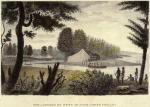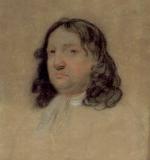![header=[Marker Text] body=[Oct. 29, 1682, soon after finishing a two-months' voyage, William Penn first set foot on his colony of Pennsylvania, granted by Charles II the year before. The site is a block south. ] sign](kora/files/1/10/1-A-25-139-ExplorePAHistory-a0a1n5-a_450.gif)
Mouse over for marker text
Name:
Penn Landing
Region:
Philadelphia and its Countryside/Lehigh Valley
County:
Delaware
Marker Location:
SE corner, 2nd (PA 291) & Penn Streets, Chester
Dedication Date:
October 13, 1947
Behind the Marker
On August 30, 1682, well-wishers gathered on the docks, shouted fare thee well, waved handkerchiefs and wished everyone a safe trip, as the Welcome, under the command of Captain Robert Greenway, sailed out of Deal harbor in England bound for far away Pennsylvania. The three hundred-ton ship was packed with baggage and crates, barrels of biscuit, pickled beef and pork, kegs of beer, cattle, pigs, sheep, and one hundred passengers (mostly Quakers from Sussex), including the proprietor of their New World destination, William Penn.
A few weeks out at sea, smallpox broke out onboard ship. Half of the crew and passengers on the vessel fell ill with the deadly disease. Penn, who had been infected as a child, was immune. But thirty people died and were buried at sea. On October 27, the ship sailed up the Delaware Bay and docked at New Castle (in present-day Delaware).
There, the English, Dutch and Welsh inhabitants of the town enacted an ancient ceremony, presenting Penn with a piece of turf with a twig in it and a small metal bowl of river water. Thus William Penn officially took possession of the land south of Pennsylvania along the river known as "the three lower counties," land that a few decades later would become the colony of Delaware.
The next day on a bright clear, crisp fall morning, the Welcome sailed upriver and anchored near the Swedish settlement of Upland. There, Penn first set foot in Pennsylvania. Legend has it that Penn gave an English name to the settlement at the suggestion of a friend, calling the hamlet and the surrounding county "Chester" after Cheshire in England.
That same year, the first Pennsylvania legislature met in Upland/Chester. Three weeks after he arrived in the colony, Penn issued a proclamation calling for elections in all three counties to send representatives to a general assembly meeting at Upland. On December 4, 1682, delegates arrived, and after electing a chairman and appointing committees, passed laws formally annexing "the three lower counties" (later called Delaware) and naturalizing the Dutch, Finnish and
Finnish and  Swedish settlers in the province. They also considered and then passed a number of laws from documents that Penn's legal advisors had drawn up in England for the governance of the colony.
Swedish settlers in the province. They also considered and then passed a number of laws from documents that Penn's legal advisors had drawn up in England for the governance of the colony.
Today a marker commemorates the spot where Penn first set foot on Pennsylvania soil. Located at the corner of Penn and Front Streets in Chester, the marker also marks the site of Robert Wade's log house.
A few weeks out at sea, smallpox broke out onboard ship. Half of the crew and passengers on the vessel fell ill with the deadly disease. Penn, who had been infected as a child, was immune. But thirty people died and were buried at sea. On October 27, the ship sailed up the Delaware Bay and docked at New Castle (in present-day Delaware).
There, the English, Dutch and Welsh inhabitants of the town enacted an ancient ceremony, presenting Penn with a piece of turf with a twig in it and a small metal bowl of river water. Thus William Penn officially took possession of the land south of Pennsylvania along the river known as "the three lower counties," land that a few decades later would become the colony of Delaware.
The next day on a bright clear, crisp fall morning, the Welcome sailed upriver and anchored near the Swedish settlement of Upland. There, Penn first set foot in Pennsylvania. Legend has it that Penn gave an English name to the settlement at the suggestion of a friend, calling the hamlet and the surrounding county "Chester" after Cheshire in England.
That same year, the first Pennsylvania legislature met in Upland/Chester. Three weeks after he arrived in the colony, Penn issued a proclamation calling for elections in all three counties to send representatives to a general assembly meeting at Upland. On December 4, 1682, delegates arrived, and after electing a chairman and appointing committees, passed laws formally annexing "the three lower counties" (later called Delaware) and naturalizing the Dutch,
Today a marker commemorates the spot where Penn first set foot on Pennsylvania soil. Located at the corner of Penn and Front Streets in Chester, the marker also marks the site of Robert Wade's log house.







